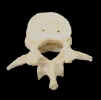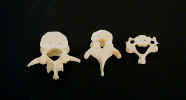

 Superior view
Superior view Superior view
Superior viewThe five lumbar vertebrae can be recognized by several features. They have a short, blunt spinous process that projects in a posterior direction. Their transverse processes project laterally and are relatively long (Dr. J says they look like the wings of a glider). They have relatively small vertebral foramina since the spinal cord is very thin by the time it gets to the lumbar region. In fact, it normally ends at the inferior edge of L1 body in the adult human. The sagittal plane of the lumbar vertebrae allow for the most flexibility in anterior/posterior direction. In the adult the body is relatively large when compared to vertebrae from other regions. This size is important because the lumbar vertebrae are supporting more weight than any of the vertebrae superior to them.
COPYRIGHT
2007 by William C. Johnson II
ALL RIGHTS RESERVED!